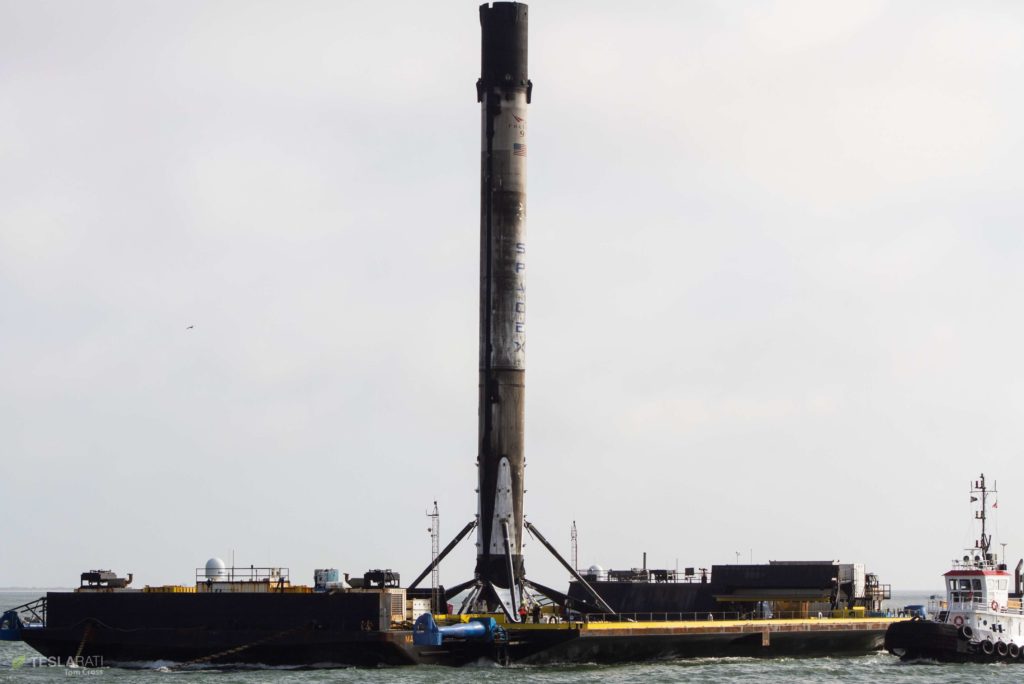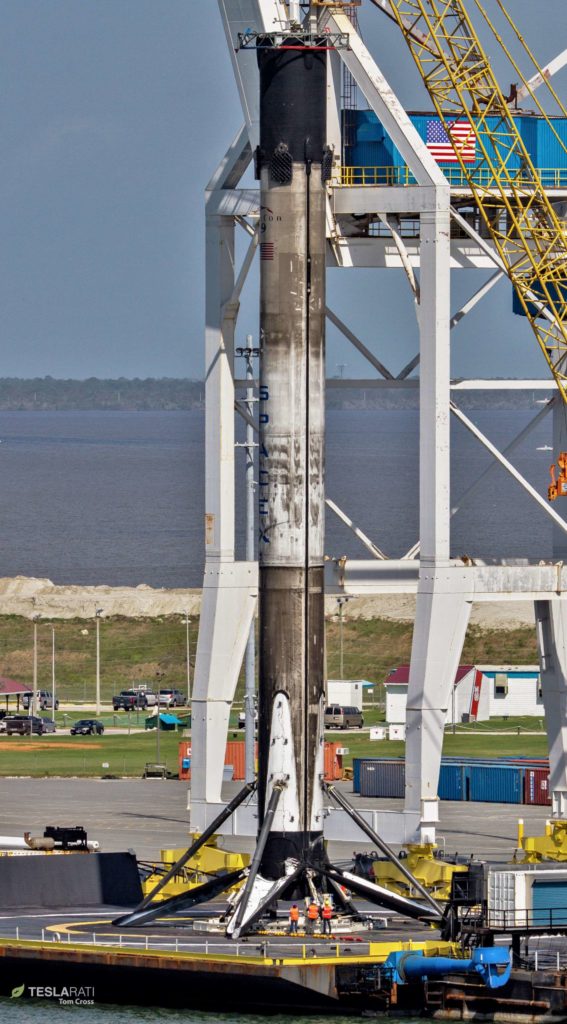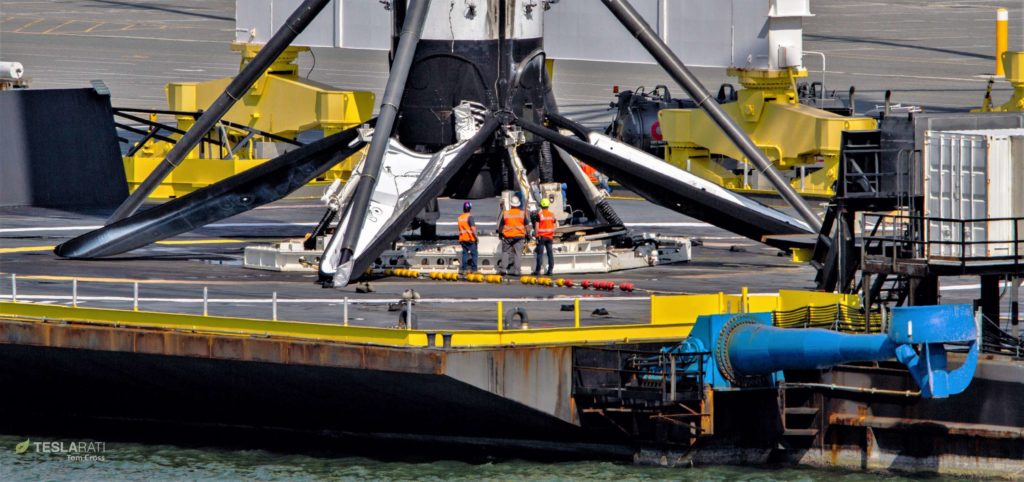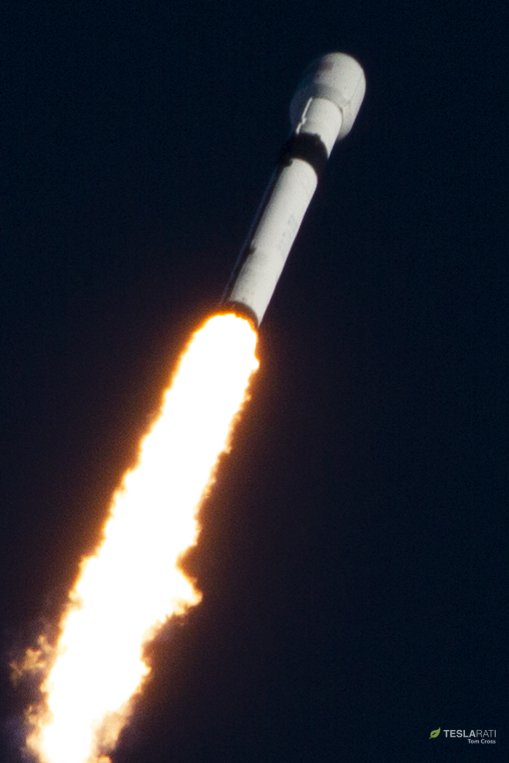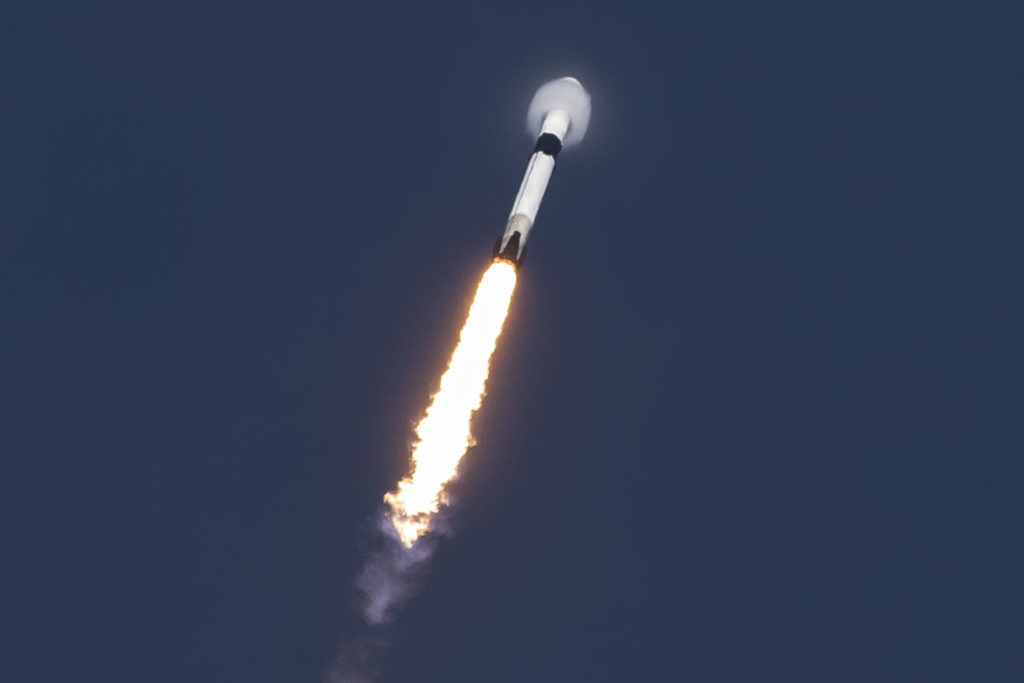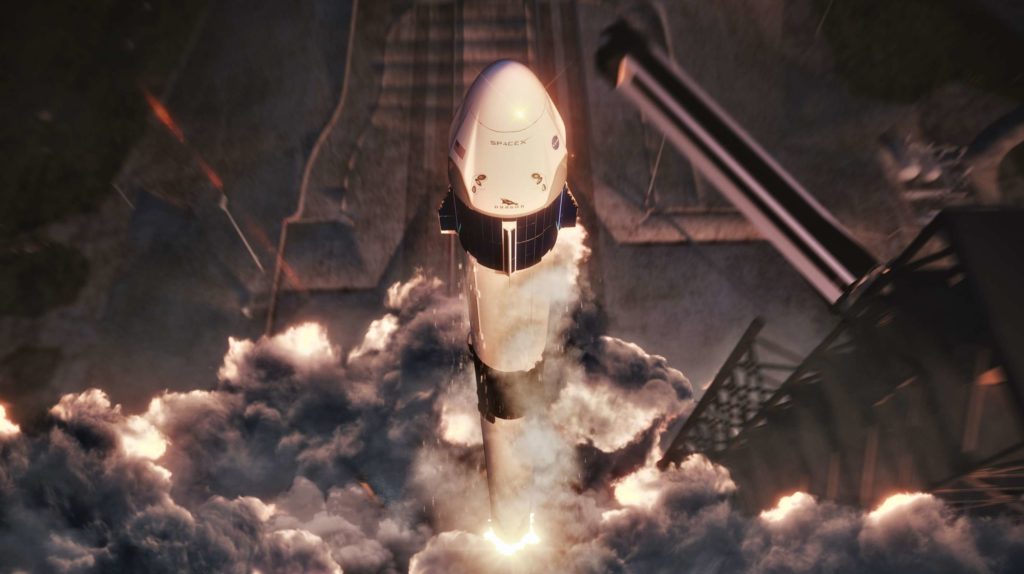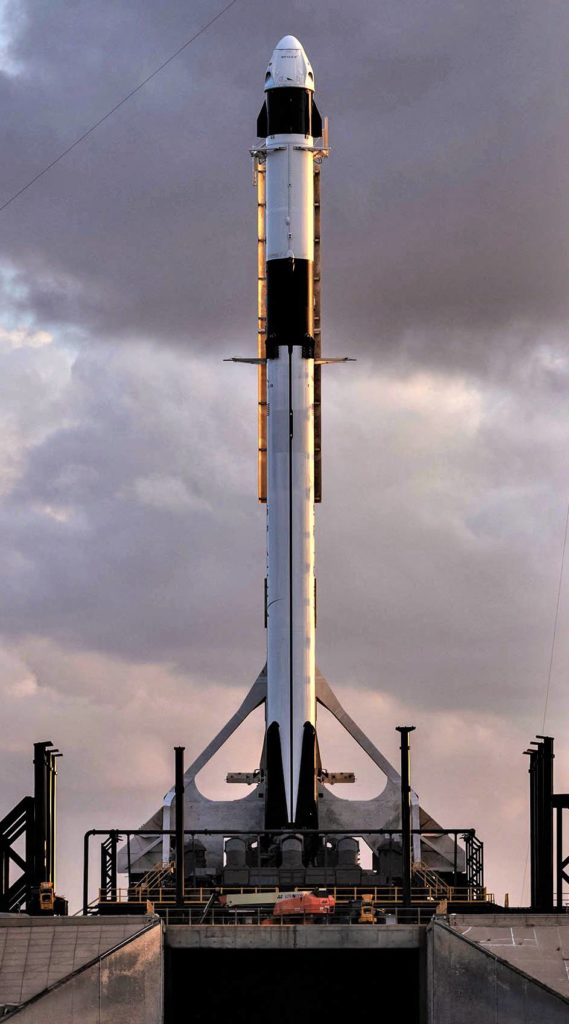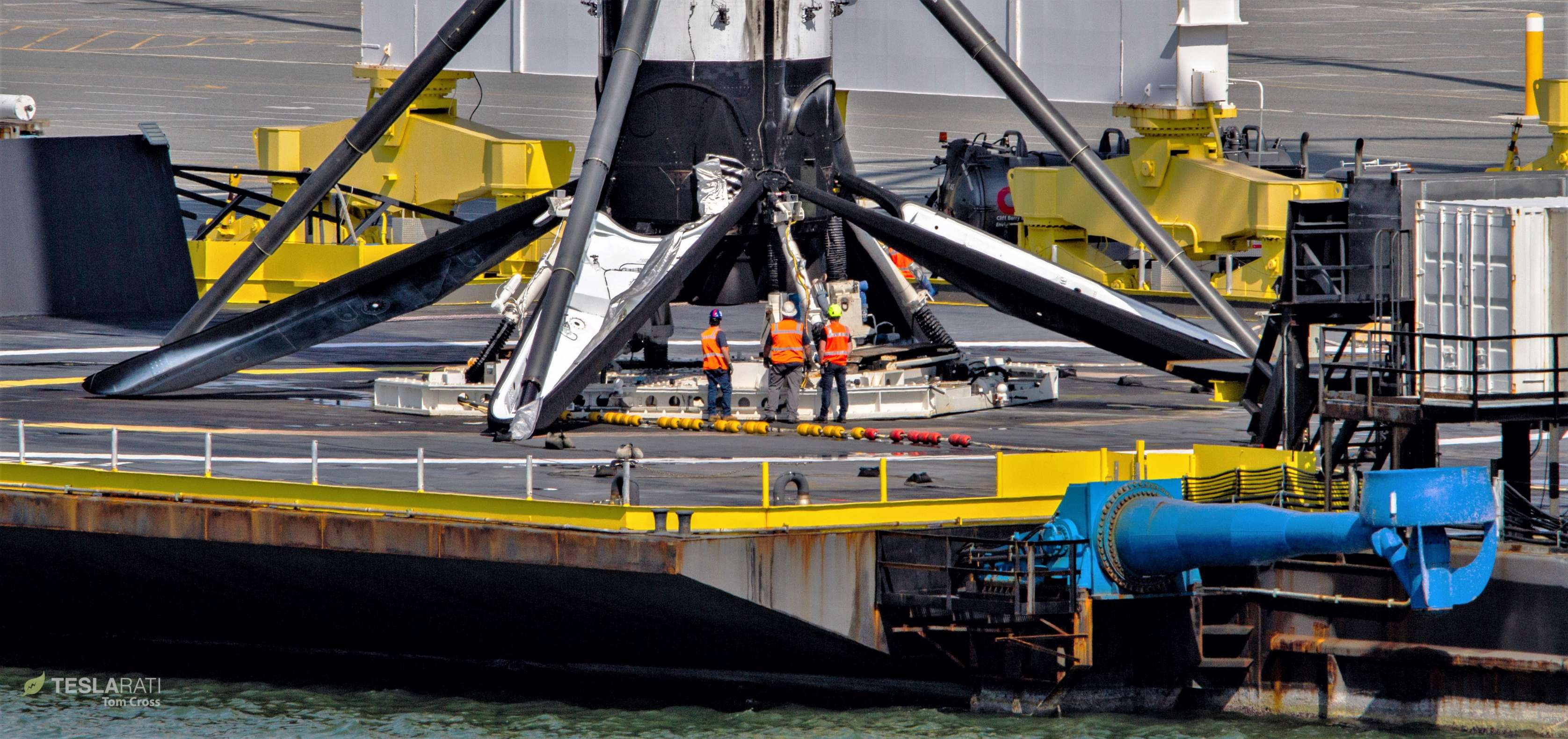

SpaceX
SpaceX Falcon 9 rocket lands for the last time ahead of risky in-flight abort test
SpaceX’s latest successful launch and landing has wrapped up with Israeli Moon lander Beresheet on its way to Earth’s neighbor, Indonesian communications satellite PSN-6 headed to its final orbit, and the second thrice-flown Falcon 9 Block 5 booster safely returned to Port Canaveral aboard drone ship Of Course I Still Love You (OCISLY).
Known as Falcon 9 B1048, its third successful landing and recovery will almost certainly be this booster’s last after its fourth launch was officially assigned to a critical Crew Dragon launch abort test, one that the booster is very unlikely to survive. According to SpaceX CEO Elon Musk, that test could occur as early as April and will push the first flight-proven Crew Dragon space capsule to its limits.
https://twitter.com/_TomCross_/status/1099688043009753088
After weathering what Musk also described as the toughest reentry and heating conditions yet experience by a Falcon 9 booster meant for recovery, Falcon 9 B1048 landing (almost) flawlessly aboard drone ship OCISLY, stationed roughly 700 km (430 mi) off the Florida coast. Hinted at by the booster’s very slight lean on the recovery vessel’s deck, B1048 most likely cut thrust (or ran out of fuel) just before the optimal stop point, causing the rocket to fall a few unintended feet onto OCISLY and eat into part of the aluminum honeycomb ‘crush-core’ present on all Falcon landing legs.
Reentry, even at 1/4 of orbital speed is hard pic.twitter.com/Tk2KJblWH5
— Scott Manley (@DJSnM) February 22, 2019
In essence, that crushable aluminum acts as a very rough form of emergency suspension meant to minimize potential damage to the fragile structure of Falcon booster propellant tanks at the cost of its landing legs. In the case of B1048’s third landing, the lean appears to be no more than a few degrees – scarcely out of the ordinary, at least relative to past leaning boosters. Most notably, Falcon 9 B1023 experienced a similar anomaly and a far worse lean after its first landing, an experience that did not apparently impact its ability to launch for the second time as a side booster for Falcon Heavy’s inaugural launch.
- Falcon 9 B1048 returned to Port Canaveral on February 24th after its third successful launch and landing. (Teslarati)
- B1048.3 beside its human caretakers. (Tom Cross)
- Octagrabber robots are meant to prevent boosters from sliding off of drone ship decks by anchoring them with their tank-like weight. (Teslarati)
B1048’s slight departure from a perfect trajectory should thus pose no problem for in-place plans for the rocket’s fourth (and likely final) launch. Known as Crew Dragon’s in-flight abort (IFA) test, SpaceX specifically requested the inclusion of a second abort test (above and beyond NASA’s testing requirements) to fully verify that astronauts could be pulled to safety at any point during launch. In 2015, the company completed a pad abort test of Crew Dragon, demonstrating that the spacecraft could escape from a failing rocket while static on the launch pad. The in-flight abort is precisely what it sounds like: a demonstration that Crew Dragon can safely escape a failing rocket while in flight. More than simply being in flight, the goal is to demonstrate a successful abort at the point of peak aerodynamic stress of Falcon 9 and Dragon, known as Max Q.
For Cargo Dragon launches, Falcon 9 has typically averaged dynamic forces of about 25 kPa (~4 psi), roughly equivalent to 2.5 tons of force per square meter. During launch, either the payload fairing or Cargo/Crew Dragon are subjected directly to those forces, often requiring a significant period of lower throttle to mitigate the forces those sensitive assemblies experience. Given that Crew Dragon’s abort scenario accelerates the capsule and trunk from a relative speed of zero to nearly 350 mph (150 m/s) in five seconds, the dynamic forces (i.e. mechanical loads and heating) the spacecraft is experiencing could jump 50% or more almost instantaneously.
- Falcon 9 B1054 around the time of Max Q. (Tom Cross)
- While it doesn’t necessarily correlate with Max Q, vapor cones like the one on B1047’s fairing are a partial visualization of Max Q forces. (SpaceX)
- An official SpaceX render shows Falcon 9 and Crew Dragon lifting off from Pad 39A. (SpaceX)
- Falcon 9 B1051 and Crew Dragon vertical at Pad 39A. (SpaceX)
After Crew Dragon aborts, the Falcon 9 stack – featuring B1048 and a full-fidelity upper stage with a mass simulator in place of its MVac engine – will be instantaneously exposed to those same dynamic forces, experientially equivalent to bellyflopping from an Olympic-height diving platform. The upper stage may actually be better off than the booster thanks to the generally smooth dome at its stern, whereas Falcon 9’s booster would have its interstage – a deep, open cylinder – exposed to the same airflow if or when the upper stage is torn away. At the point of abort, Falcon 9 will most likely be in the process of shutting down its Merlin 1D engines, effectively removing the booster’s control authority and leaving it at the mercy of the atmosphere. SpaceX’s CRS-7 Cargo Dragon failure (caused by the second stage losing structural integrity mid-flight) is actually a decent representation of what is likely to happen to B1048 and its upper stage.
Given the potential destructive power B1048 will face, not to mention the fact that the booster will likely not have grid fins or landing legs installed, today’s recovery will probably be the last time the rocket returns to port and prepares for another launch. Explicitly dependent upon the refurbishment of DM-1’s Crew Dragon capsule, SpaceX’s in-flight abort is not expected to occur until June 2019, although Musk has indicated that the aspirational target is to perform the test as early as April, perhaps less than 60 days after the capsule is scheduled to land in the Atlantic Ocean.
Check out Teslarati’s newsletters for prompt updates, on-the-ground perspectives, and unique glimpses of SpaceX’s rocket launch and recovery processes!
News
SpaceX launches Ax-4 mission to the ISS with international crew
The SpaceX Falcon 9 launched Axiom’s Ax-4 mission to ISS. Ax-4 crew will conduct 60+ science experiments during a 14-day stay on the ISS.

SpaceX launched the Falcon 9 rocket kickstarting Axiom Space’s Ax-4 mission to the International Space Station (ISS). Axiom’s Ax-4 mission is led by a historic international crew and lifted off from Kennedy Space Center’s Launch Complex 39A at 2:31 a.m. ET on June 25, 2025.
The Ax-4 crew is set to dock with the ISS around 7 a.m. ET on Thursday, June 26, 2025. Axiom Space, a Houston-based commercial space company, coordinated the mission with SpaceX for transportation and NASA for ISS access, with support from the European Space Agency and the astronauts’ governments.
The Ax-4 mission marks a milestone in global space collaboration. The Ax-4 crew, commanded by U.S. astronaut Peggy Whitson, includes Shubhanshu Shukla from India as the pilot, alongside mission specialists Sławosz Uznański-Wiśniewski from Poland and Tibor Kapu from Hungary.
“The trip marks the return to human spaceflight for those countries — their first government-sponsored flights in more than 40 years,” Axiom noted.
Shukla’s participation aligns with India’s Gaganyaan program planned for 2027. He is the first Indian astronaut to visit the ISS since Rakesh Sharma in 1984.
Axiom’s Ax-4 mission marks SpaceX’s 18th human spaceflight. The mission employs a Crew Dragon capsule atop a Falcon 9 rocket, designed with a launch escape system and “two-fault tolerant” for enhanced safety. The Axiom mission faced a few delays due to weather, a Falcon 9 leak, and an ISS Zvezda module leak investigation by NASA and Roscosmos before the recent successful launch.
As the crew prepares to execute its scientific objectives, SpaceX’s Ax-4 mission paves the way for a new era of inclusive space research, inspiring future generations and solidifying collaborative ties in the cosmos. During the Ax-4 crew’s 14-day stay in the ISS, the astronauts will conduct nearly 60 experiments.
“We’ll be conducting research that spans biology, material, and physical sciences as well as technology demonstrations,” said Whitson. “We’ll also be engaging with students around the world, sharing our experience and inspiring the next generation of explorers.”
SpaceX’s Ax-4 mission highlights Axiom’s role in advancing commercial spaceflight and fostering international partnerships. The mission strengthens global space exploration efforts by enabling historic spaceflight returns for India, Poland, and Hungary.
News
Starlink Cellular’s T-Mobile service to grow with third-party app data
From Oct 2025, T-Satellite will enable third-party apps in dead zones! WhatsApp, X, AccuWeather + more coming soon.

Starlink Cellular’s T-Mobile service will expand with third-party app data support starting in October, enhancing connectivity in cellular dead zones.
T-Mobile’s T-Satellite, supported by Starlink, launches officially on July 23. Following its launch, T-Mobile’s Starlink Cellular service will enable data access for third-party apps like WhatsApp, X, Google, Apple, AccuWeather, and AllTrails on October 1, 2025.
T-Mobile’s Starlink Cellular is currently in free beta. T-Satellite will add MMS support for Android phones on July 23, with iPhone support to follow. MMS support allows users to send images and audio clips alongside texts. By October, T-Mobile will extend emergency texting to all mobile users with compatible phones, beyond just T-Mobile customers, building on its existing 911 texting capability. The carrier also provides developer tools to help app makers integrate their software with T-Satellite’s data service, with plans to grow the supported app list.
T-Mobile announced these updates during an event celebrating an Ookla award naming it the best U.S. phone network, a remarkable turnaround from its last-place ranking a decade ago.
“We not only dream about going from worst to best, we actually do it. We’re a good two years ahead of Verizon and AT&T, and I believe that lead is going to grow,” said T-Mobile’s Chief Operating Officer Srini Gopalan.
T-Mobile unveiled two promotions for its Starlink Cellular services to attract new subscribers. A free DoorDash DashPass membership, valued at $10/month, will be included with popular plans like Experience Beyond and Experience More, offering reduced delivery and service fees. Meanwhile, the Easy Upgrade promotion targets Verizon customers by paying off their phone balances and providing flagship devices like the iPhone 16, Galaxy S25, or Pixel 9.
T-Mobile’s collaboration with SpaceX’s Starlink Cellular leverages orbiting satellites to deliver connectivity where traditional networks fail, particularly in remote areas. Supporting third-party apps underscores T-Mobile’s commitment to enhancing user experiences through innovative partnerships. As T-Satellite’s capabilities grow, including broader app integration and emergency access, T-Mobile is poised to strengthen its lead in the U.S. wireless market.
By combining Starlink’s satellite technology with strategic promotions, T-Mobile is redefining mobile connectivity. The upcoming third-party app data support and official T-Satellite launch mark a significant step toward seamless communication, positioning T-Mobile as a trailblazer in next-generation wireless services.
News
Starlink expansion into Vietnam targets the healthcare sector
Starlink aims to deliver reliable internet to Vietnam’s remote clinics, enabling telehealth and data sharing.

SpaceX’s Starlink expansion into Vietnam targets its healthcare sector. Through Starlink, SpaceX seeks to drive digital transformation in Vietnam.
On June 18, a SpaceX delegation met with Vietnam’s Ministry of Health (MoH) in Hanoi. SpaceX’s delegation was led by Andrew Matlock, Director of Enterprise Sales, and the discussions focused on enhancing connectivity for hospitals and clinics in Vietnam’s remote areas.
Deputy Minister of Health (MoH) Tran Van Thuan emphasized collaboration between SpaceX and Vietnam. Tran stated: “SpaceX should cooperate with the MoH to ensure all hospitals and clinics in remote areas are connected to the StarLink satellite system and share information, plans, and the issues discussed by members of the MoH. The ministry is also ready to provide information and send staff to work with the corporation.”
The MoH assigned its Department of Science, Technology, and Training to work with SpaceX. Starlink Vietnam will also receive support from Vietnam’s Department of International Cooperation. Starlink Vietnam’s agenda includes improving internet connectivity for remote healthcare facilities, developing digital infrastructure for health examinations and remote consultations, and enhancing operational systems.
Vietnam’s health sector is prioritizing IT and digital transformation, focusing on electronic health records, data centers, and remote medical services. However, challenges persist in deploying IT solutions in remote regions, prompting Vietnam to seek partnerships like SpaceX’s.
SpaceX’s Starlink has a proven track record in healthcare. In Rwanda, its services supported 40 health centers, earning praise for improving operations. Similarly, Starlink enabled remote consultations at the UAE’s Emirati field hospital in Gaza, streamlining communication for complex medical cases. These successes highlight Starlink’s potential to transform Vietnam’s healthcare landscape.
On May 20, SpaceX met with Vietnam’s Ministry of Industry and Trade, announcing a $1.5 billion investment to provide broadband internet, particularly in remote, border, and island areas. The first phase includes building 10-15 ground stations across the country. This infrastructure will support Starlink’s healthcare initiatives by ensuring reliable connectivity.
Starlink’s expansion in Vietnam aligns with the country’s push for digital transformation, as outlined by the MoH. By leveraging its satellite internet expertise, SpaceX aims to bridge connectivity gaps, enabling advanced healthcare services in underserved regions. This collaboration could redefine Vietnam’s healthcare infrastructure, positioning Starlink as a key player in the nation’s digital future.
-

 Elon Musk2 days ago
Elon Musk2 days agoTesla investors will be shocked by Jim Cramer’s latest assessment
-

 News1 week ago
News1 week agoTesla Robotaxi’s biggest challenge seems to be this one thing
-

 Elon Musk2 weeks ago
Elon Musk2 weeks agoElon Musk slams Bloomberg’s shocking xAI cash burn claims
-

 News2 weeks ago
News2 weeks agoTexas lawmakers urge Tesla to delay Austin robotaxi launch to September
-

 Elon Musk1 week ago
Elon Musk1 week agoFirst Look at Tesla’s Robotaxi App: features, design, and more
-

 Elon Musk2 weeks ago
Elon Musk2 weeks agoTesla Robotaxis are becoming a common sight on Austin’s public roads
-

 Elon Musk2 weeks ago
Elon Musk2 weeks agoSpaceX President meets India Minister after Starlink approval
-

 Elon Musk2 weeks ago
Elon Musk2 weeks agoxAI’s Grok 3 partners with Oracle Cloud for corporate AI innovation

